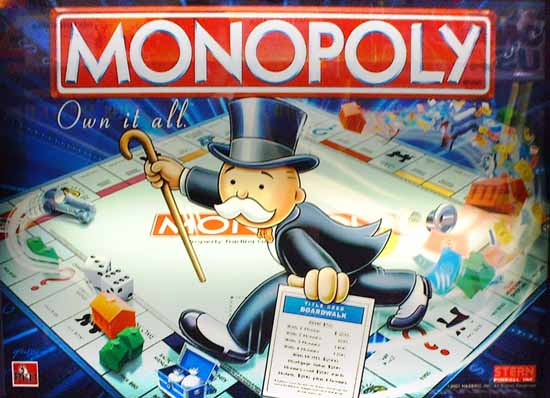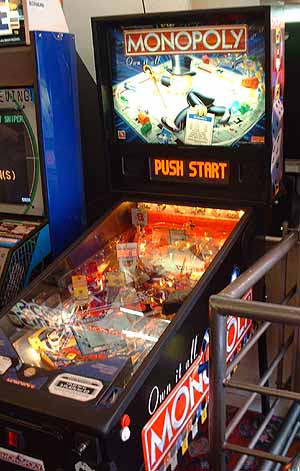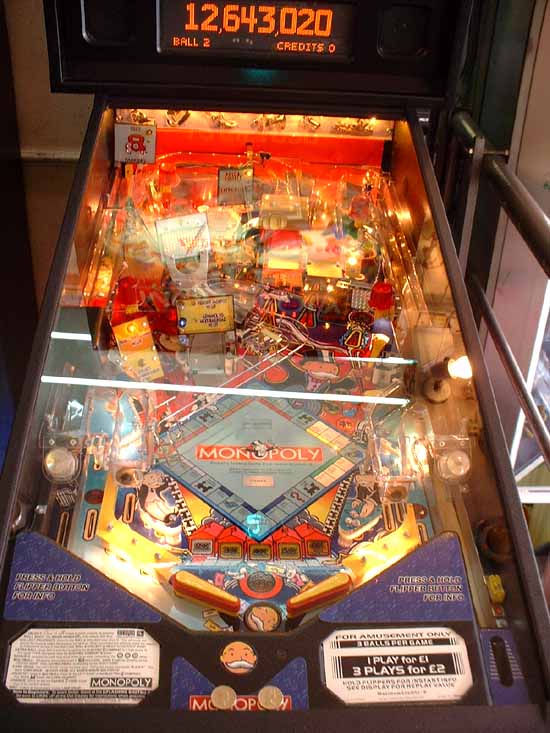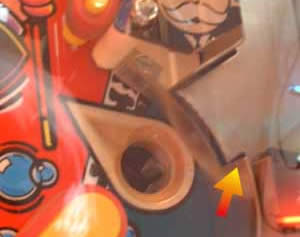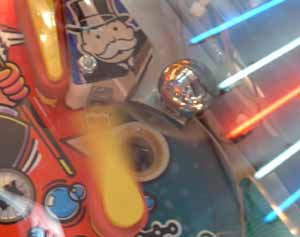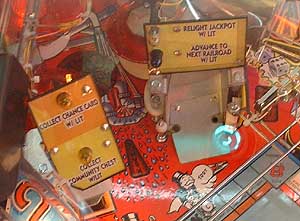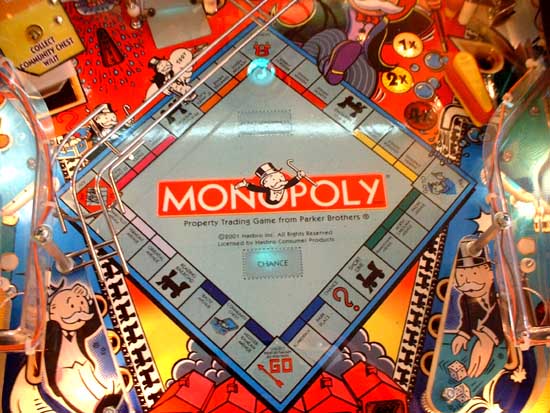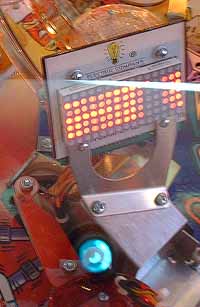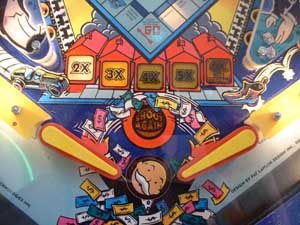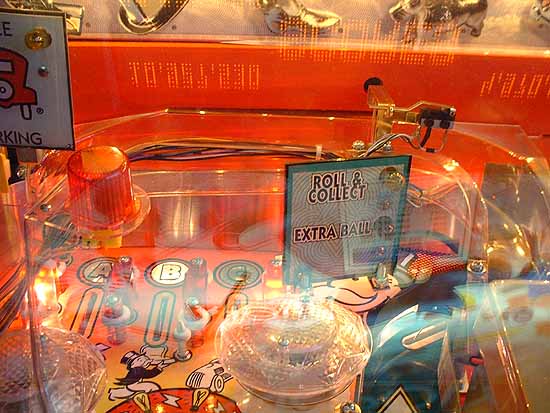|
|
|
MONOPOLY
|
|
I expect by now you've read our first site report of the Monopoly prototype game. What we have here in Central London is a sample game, one that is - to all intents - the final production game.
There may be a few minor cosmetic differences but this is essentially the game you'll see in arcades and at shows. The information here is all gained by actually playing the game.
It's difficult to judge this game fairly. It's a Pat Lawlor Design game and with that comes a certain level of expectation. We've had some great offerings from this team when they were at William's and many have become de-rigeur elements of any modern pinball collection. But that was then. Now we have a very different climate for pinball sales. Stern Pinball is the only show in town and they only exist because they can adjust to the demands for reduced complexity, lower costs and more reliability. There is no possibility that Monopoly will rank alongside games like Twilight Zone or Roadshow when you're comparing playfield toys, sound quality or general polish. For this game to hold it's head up at the Lawlor family gathering it has to have superb playability, be quickly engaging, keep delivering nice touches throughout the game, and have the depth required by more experienced players. With that in mind what do we get?
The crisp clean cabinet artwork ensures that the game looks new and fresh. The playfield also looks great with plenty of bright vibrant colours and a large number of playfield inserts. Then, of course, there's the Monopoly board itself as we've all come to know and love, though of course for us non-Americans the names are unfamiliar. So, with a stack of pound coins at the ready, we start our first game. Immediately we've got 1,500 points just for kicking a ball into the shooter lane. Austin Powers did this too and it seems bizarre to get 1,500 points for doing nothing. In fact the 1,500 equates to the amount of money you're given at the start of a game of monopoly and is a nice tie-in to the original board game. It's immediately noticeable that the background music is very quiet in comparison to the speech. It's barely audible though this may be adjustable in the game settings. Even so, this isn't an exceptionally busy arcade and even with nobody playing any other games nearby you really can't hear the music when the effects are at a good volume. This game has music by Chris Granner, I love his previous work and I WANT TO HEAR IT!!! Anyway, the plunger is a manual one with an auto-launcher for multiballs. The ball can be plunger to either the top left rollovers (strong), the upper flipper (medium) or a curious skill shot (weak). It's hard to describe exactly how this works but I'll give it a go. 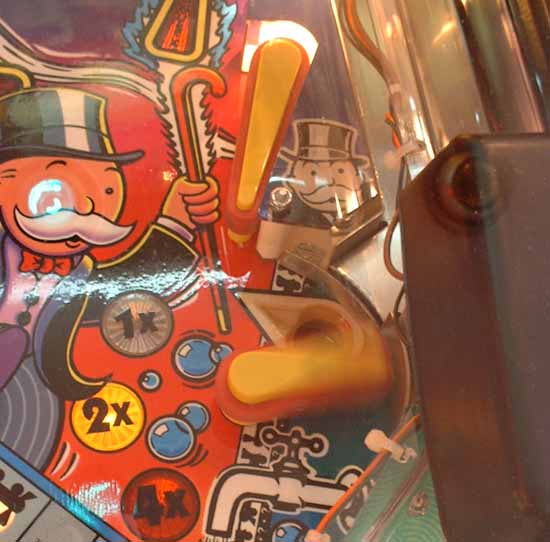
There's a small saucer which can hold the ball. It has a switch to score the skill shot award. The ball can fall into this from the shooter lane if you plunge weakly enough, but it has a tendency not to fall into the saucer but instead just roll away towards the flippers. Next to this saucer is a mini-flipper (think of the Thing Flips flipper) which rotates constantly (all through the game in fact). This "magic-flipper" spins at a rate of about one spin every 2 seconds to start with, though it speeds up later in the game. It can rotate both clockwise and counter-clockwise. The magic-flipper can sweep the ball into the saucer if you time it right or knock it away. It is also the only means of getting the ball out of the saucer and it does this by sweeping over the saucer and pushing the ball as it goes. As a skill shot it works well although for a novice there seems to be a fair amount of luck in timing it right. Should the magic-flipper fail I don't see how a ball can be cleared from the saucer. Lets hope it doesn't. Also the ball can be trapped by the magic-flipper against one of the rubbers or the upper flipper. Thankfully the motor doesn't burn out but eventually reverses direction and frees the ball. If the ball fails to make the skill shot and drains between the flippers it is returned to the shooter lane for another attempt. There is no sensor to detect a failed skill shot, just the activation of another playfield switch.
There's an annoyance with the skill shot. The ball can become stuck on a small lip of metal that forms the shooter lane wall. The game needs a decent push to free the ball and on a more sensitive tilt could lead to the loss of that ball. This metal piece is either manufactured incorrectly of badly installed. Also, at the start of the game the skill shot is worth very few points and probably not worth bothering with - you would be better off going for the left ramp shot. So the ball is in play, what do we shoot for? That's quite an important question because initially the playfield is rather confusing. There are plenty of shots but what shot does what is not immediately obvious.
There is also a lack of sound samples to spur you on. They get going later in the game but at the start it's all very quiet and it gets lonely out there. The confusion is eased after playing the first game and it helps if you actually read the instruction card (does anyone?) but even so a game like Austin Powers is much more accessible and easier to learn. You have to hope that novice players will hang around for a second game. If you persevere you get a good reward for your efforts. Beneath the slightly daunting shell is a likeable game with some nice touches although there's not enough humour for my liking.
The game is - not surprisingly - based around the Monopoly board which is set into the lower part of the playfield. To get the whole board in the game the illumination for each street is very close together and everything is tightly packed in. From the top it just looks a bit scaled down but things must be very close together underneath. The idea is to travel around the board by making various shots, each of which advance you a certain number of places. Pass "Go" and you light a lock on the centre ramp. Balls are actually locked in a pseudo left plunger lane and multiball is started from the right ramp which feeds back to the plunger lane. There's a slightly disconcerting delay between the ball coming to rest in the lock area and the game recognising the fact. The left ramp (made from the upper flipper) scores jackpots but initially it wasn't clear where you relight the jackpot. It turned out to be the small (and quick) Railroad ramp which did have a flashing lamp above it but it really wasn't visible as the plastic it was mounted on was very low-key and the lamps themselves really quite dim. The display said to shoot for the railroad ramp but it took about a minute of searching the playfield to find the small railroad image you can see top left of the image above. The second jackpot is flagged as a double-jackpot and the third as a triple jackpot but there's almost no free time after the penultimate ball has drained to try and grab one last jackpot even if the last ball was held in a saucer. In fact none of the modes give any latitude in this area, a disappointment as Stern were just getting used to the idea. The left ramp is a trifle strange too. It's not that easy to make in the first place but you have to get the strength of the shot just right. Too weak and you won't hit the standup target at the very top of the ramp. Too strong and the ball can shoot all the (wrong) way round the loop and down the centre ramp heading straight down the middle. The centre ramp isn't too good in the proper direction, either. Strong shots fly up and hit the microswitch mounted overhead and then just fall back down the ramp. It's nice, though, to actually be able to make strong shots. The flippers on Monopoly certainly seem stronger than on previous Stern games and you don't get worn out wrists just trying to get the ball up a ramp. Again, this might be a result of the coil power being turned up in a menu setting but lets hope not.
Besides playing multiball, you can throw the dice and move around the board. Each square you land on gives an award, some simply points and others start modes or give general awards. You also light the square and so build towards the wizard mode Land Grab. Lawlor fans will be please to spot a couple of references to earlier games. One of the quotes is "That's the spirit" and then there's RipOff Multiball mode from No Good Gofers. Overall, the lighting is slightly disappointing. There's no classic multiball light show like we're used to from Addams Family, there's just a brief amount of random flashes and we're off. Perhaps you need to play the game in a darker room but the use of flashers was only average.
Incidentally, the game locked up on one occasion during Free Money mode when the ball went into the Chance scoop and the animation was cancelled with the flipper buttons. The ball just remained in the scoop and the game didn't initiate a ball search. The display just showed the score all the time. Instant Info worked as did the tilt warning but it needed a power cycle to kick the ball out of the scoop. So that's a summary of how the game works but how does it play? Obviously that's a subjective matter but I think I can narrow it down to a few discrete areas. Ruleset: There is a good range of multiballs and modes to make. Each mode is pretty simple in itself and perhaps a few more complex or multistage modes would improve depth. The Land Grab mode is fairly hard to achieve and initially not expected or explained well. There are nice touches such as when you max out the bonus multiplier instead of a standard points award for subsequent shots you're awarded your bonus instead, and the cop target adding 5 seconds to a mode's timer. There are electric company and water company running values which I've not worked out yet and a railroad total which leads to railroad multiball. I would say this is a broad game rather than a deep one - lots to do, none of it too complicated once you've got your head around it. Shotmap: Nice. Ramp shots aside the game flows very smoothly and you can really get some high ball speeds. The classic shot through the jets on the left side is somehow much harder than it looks and a cop who pops up to block a fairly important shot but that aside you could keep the ball rolling for a long time before it has to stop. The longer shots can be quite tough too if you're not spot on but if you miss, the upper flipper can usually come into play for another choice. Artwork: Youssi. Sound: Couldn't hear the backing theme but there are some *very* nice spot effects in there, especially the chorus when you get an extra ball. I'm not very enthusiastic about the voice artist though. He doesn't seem to have enough enthusiasm and jollity in his voice apart from a couple of woo-hoos. Display: There is some good work here. The animations are good and much clearer than you might expect. The multiball animation is quick but impressively memorable. A slight oddity in the high-score table, you can enter 10 high scores but only 3 are shown in attract mode (the rest are viewable using instant info). Construction: This is where the game is let down from a potential home-owners viewpoint. The game looks, frankly, cheap.
There is a lot of highly visible wiring and several bare microswitches which need covers. The bank vault is rather, err, minimalist, and the metalwork around the back of the playfield looks unfinished. Where you might expect ramp decals there are none and the back of the playfield looks like a piece of red cardboard. Now I have to make a value judgement on the game as a whole and it's tricky. As I outlined at the start of this review we're in a different pinball environment now and it's still takes some getting used to. I had high (and perhaps unachievable) hopes for this game and in all honesty I can't say it's as good as I'd hoped. But really it doesn't miss by very much. It is basically a good enjoyable game as you can see by the fact that I played it for what seemed about an hour and a half. In fact I'd been playing for over four hours and still wanted to play some more. I haven't totally got my head around all the features yet so there may be a lot of strategic planning needed to get to the next level of enjoyment. I did also find it frustrating at times when there was no ball saver and one game lasted about 30 seconds, but then again one decent game must have lasted 30 minutes and that was a hoot. It's even hard to compare it to Austin Powers as the two games are so dissimilar. I suppose Monopoly is more of a players game while AP has a broader appeal and might bring in new players. In the end, Monopoly owes more to No Good Gofers and Safecracker than Addams and Twilight which is inevitable if not my personal preference. Ultimately, though, you'll just have to find out for yourself.
© Pinball News 2002 |

